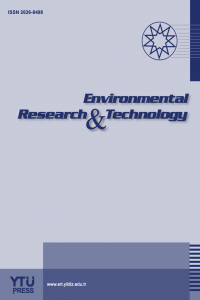Investigation into the possibility of using a novel ionic liquid leaching method to obtain vanadium from vanadium slag
Investigation into the possibility of using a novel ionic liquid leaching method to obtain vanadium from vanadium slag
___
- References [1]. Moskalyk, R. R. & Alfantazi, A. M., 2003. Processing of Vanadium: a review. Minerals Engineering, 16(9), pp. 793-805.
- [2]. Zhang, L. & Zheng, S., 2011. Acid leaching of calcined vanadium titanomagnetite with calcium compounds for extraction of vanadium. Chinese Journal of Process Engineering, 11(4), pp. 573-578
- [3]. Huang, D., 2000. Vanadium extraction & steelmaking. Beijing, China: Metallurgy Industry Press. [4]. Liu, B. & Meng, L., 2018. A novel method to extract vanadium from high-grade slag: Non-salt roasting and alkaline leaching. Physicochemical Problems of Mineral Processing, 54(3), pp. 657-667.
- [5]. Navarror, R., 2007. Vanadium recovery from oil fly ash by precipitation and solvent extraction processes. Waste Management, 27(3), pp. 114-119.
- [6]. Nkosi, S. & Dire, N., 2017. A comparative study of vanadium recovery from titaniferous magnietite using salt, sulphate, and soda ash roast-leach processes. In: 3rd Young Professionals Conference: Innovation Hub. Pretoria: The Southern African Institute of Mining and Metallurgy, pp. 191-200.
- [7]. Chen, D., Zhao, L. & Liu, Y., 2013. A novel process for recovery of iron, titanium and vanadium from titanomagnetite concentrate: NaOH molten salt roasting and water leaching. Journal of Hazardous Materials, Volume 244-245, pp. 588-595.
- [8]. Zhang, J., Zhang, W. & Zhang, L., 2015. Mechanism of vanadium slag roasting with calcium oxide. International Journal of Mineral Processing, Volume 138, pp. 20-29.
- [9]. Li, H., Wang, K. & Hua, W., 2016. Selective leaching of vanadium in calcification-roasted vanadium slag by ammonium carbonate. Hydrometallurgy, Volume 160, pp. 18-25.
- [10]. Li, R., Liu, T. & Zhang, Y., 2018. Efficient Extraction of Vanadium from Vanadium- Titanium Magnetite Concentrate by Potassium Salt Roasting Additives. Minerals, 8(25), pp. 1-14.
- [11]. Welton, T., 2004. Ionic liquids in catalysis. Coordination Chemistry Reviews, 248(21-24), pp. 2459-2477
- [12]. Bell, R. & Castleman, A. W., 1999. Vanadium oxide complexes in room-temperature chloroaluminate molten salts. Inorganic Chemistry, Volume 38, pp. 5709-5715.
- [13]. Treybal, R., 1955. Mass Transfer Operations. United States: McGraw-Hill.
- [14]. Faraji, Fariborz, Amirhossein Alizadeh, Fereshteh Rashchi, and Navid Mostoufi. 2020. “Kinetics of Leaching: A Review.” Reviews in Chemical Engineering 1(2020): 1–36.
- Yayın Aralığı: Yılda 4 Sayı
- Başlangıç: 2018
- Yayıncı: Yıldız Teknik Üniversitesi
Eda YARSUR, İlona HORVATH, Cigdem YANGİN-GOMEC
Microplastic pollution in a small fishing port in Zonguldak/Turkey
Gülçin DEMİREL BAYIK, Elif AYDEMİR
Treatment of citrus juice process wastewater with UASB and biogas production
Sevgi GÜNEŞ DURAK, Seren ACARER, Güler TÜRKOĞLU DEMİRKOL
Shahnaz SULTANA, Nazia RAHMAN, Md RAZZAK, Md Nabul SARDAR
Chemical disinfectants detoxify wastewater containing various organic substances
Sarwoko MANGKOEDİHARDJO, Latifa MİRZATİKA AL-ROSYİD
Determination of personal carbon footprint in aviation and tourism axis: Cappadocia Airport case
Herman POTGİETER, Samaneh TEİMOURİ
Padmanabhan SAMBANDAM, Vinod Kumar T, S MAHALİNGAM, Ganesan S, Giridharan K
